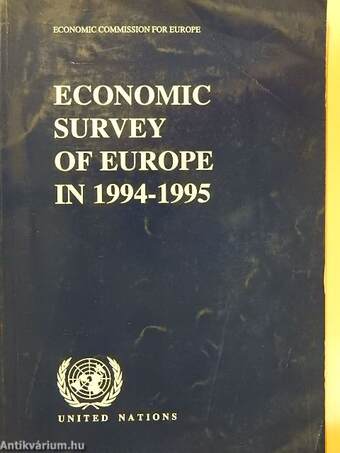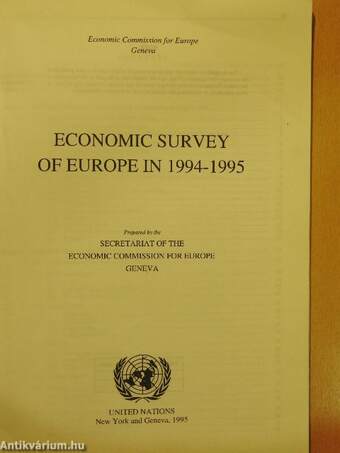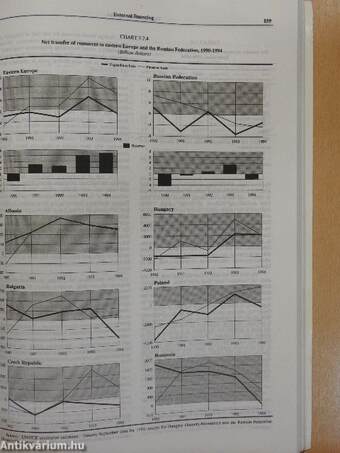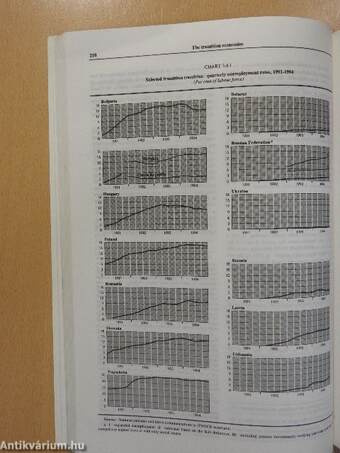1.077.076
kiadvánnyal nyújtjuk Magyarország legnagyobb antikvár könyv-kínálatát

VISSZA
A TETEJÉRE
JAVASLATOKÉszre-
vételek
Economic Survey of Europe in 1994-1995
| Kiadó: | United Nations |
|---|---|
| Kiadás helye: | New York |
| Kiadás éve: | |
| Kötés típusa: | Ragasztott papírkötés |
| Oldalszám: | 254 oldal |
| Sorozatcím: | Economic Commission for Europe |
| Kötetszám: | |
| Nyelv: | Angol |
| Méret: | 30 cm x 21 cm |
| ISBN: | 92-1-116623-3 |
| Megjegyzés: | Fekete-fehér illusztrációkkal. |
naponta értesítjük a beérkező friss
kiadványokról
naponta értesítjük a beérkező friss
kiadványokról
Előszó
PREFACE
The present Survey is the forty-eighth in a series of reports prepared by the
secretariat of the Economic Commission for Europe to serve the needs of the
Commission and to help in... Tovább
Előszó
PREFACE
The present Survey is the forty-eighth in a series of reports prepared by the
secretariat of the Economic Commission for Europe to serve the needs of the
Commission and to help in reporting on world economic conditions.
The Survey is published on the responsibility of the secretariat, and the views
expressed in it should not be attributed to the Commission or to its participating
Governments.
The pre-publication text of this Survey was completed in March 1995 as a document
for the 50th session of the Economic Commission for Europe. This text, finalized in
May 1995, incorporates minor changes. Vissza
Tartalom
contents
Explanatory notes ix
Abbreviations x
Preface xi
Chapter 1 THE ECE MARKET AND TRANSITION ECONOMIES IN EARLY 1995 1
1.1 Recent developments and the short-run outlook 1
(i) Western Europe and North America 1
(ii) The transition economies of eastern Europe and the former Soviet Union 3
1.2 The Mexican crisis and the transition economies 5
(i) Lessons from the Mexican experience 6
(ii) The role of investment 7
1.3 Five years of reform: a brief retrospective 9
(i) Building capitalism: the rise and fall of expectations in eastern Europe 9
(ii) "Infant" capitalism? 9
(iii) "Transitional" recession: too deep, too long 10
(iv) Structural unemployment 11
(v) Persistent inflation 12
(vi) Enterprise reform and privatization 12
(vii) Banking reform 13
(viii) Foreign investments 14
(ix) The need for structural reforms 14
(x) Conclusion 15
Chapter 2 THE WESTERN MARKET ECONOMIES 17
2.1 Expectations and outcomes: an overview 17
2.2 Output and demand 20
(i) Output 20
(ii) Potential output and output gaps 23
(iii) The components of demand 29
2.3 Labour markets 38
(i) Employment 38
(ii) Unemployment 41
(iii) Labour costs 47
(iv) Labour market policy 48
2.4 Prices 50
(i) World commodity prices 50
(ii) Domestic prices 51
(iii) Inflation convergence 53
2.5 External balances 54
2.6 Fiscal policy and monetary conditions 57
(i) Fiscal policy 57
(ii) Monetary conditions 59
2.7 The short-run economic outlook 66
(i) General economic developments 66
(ii) The stance of economic policy 67
(iii) Risks and uncertainties 68
Chapter 3 THE TRANSITION ECONOMIES 69
69
3.1 An overview of the transition economies in 1994
74
3.2 Output and demand
74
(l) Output 83
(ii) The private sector ^
(iii) Demand
96
3.3 Costs and prices
(i) Overview ^
(ii) Consumer prices
(iii) Producer prices
(iv) Wages 10\
(v) Sources of inflation in 1993 1UJ
3.4 Labour markets 106
(i) Overview 106
(ii) Employment 106
(iii) Unemployment 109
(iv) Vacancies 115
(v) Unemployment benefits 115
(vi) Sources and socio-economic implications of mass unemployment 117
3.5 Foreign trade of the transition economies 121
(i) Overall trade results 121
(ii) East European countries 121
(iii) The Commonwealth of Independent States 126
(iv) The Baltic states 131
(v) Trade policy developments 133
3.6 Balance of payments, debt and foreign currency reserves 135
(i) Overview 135
(ii) Developments by country 13g
3.7 External financing I45
(i) Overview of financial developments 245
(ii) Overview of financial flows: 1990-1994
(iii) Private capital flows into the transition economies J4g
(iv) Guaranteed and official credits 153
(v) Resource transfers to the transition economies J57
(vi) Financial vulnerability and the impact of Mexico
3.8 Economic policies in eastern Europe and the Baltic states
(i) Main policy priorities in 1994 1^2
(ii) Monetary policies 162
(iii) Fiscal policies 169
(iv) Foreign exchange rate policies I74
(v) Price and incomes policies 176
3.9 Economic transformation in Belarus, the Russian Federation and Ukraine 179
(i) Introduction 179
(ii) The Soviet inheritance 180
(iii) Comparative reform performance 182
(iv) Current state and prospects of transition 195
3.10 Short-term outlook
197
Chapter 4 SELECTED ASPECTS OF STRUCTURAL REFORM IN THE TRANSITION ECONOMIES 205
4.1 Reform of the banking system in eastern Europe 205
(i) Banking sector: the "soft spot" of reforms 205
(ii) Unhappy consequences of non-reforming 206
(iii) The "bad debt" problem and possible solutions , 207
(iv) The need for further reforms 210
4.2 Private sector development in the Baltic states 212
(i) Overview 212
(ii) Uncertain statistics 212
(iii) Emerging private enterprises 214
(iv) New steps in privatization 214
(v) Obstacles to fast large-scale privatization progress 217
(vi) A summary 219
Chapter 5 INTERNATIONAL MIGRATION IN CENTRAL AND EASTERN EUROPE
AND THE COMMONWEALTH OF INDEPENDENT STATES 221
5.1 Introduction 221
5.2 Historical overview 223
5.3 International migration in the early 1990s 227
(i) Migration due to armed conflicts 227
(ii) Migration between the successor states of the Soviet Union 228
(iii) Transit migration 229
(iv) The overall picture 230
5.4 A causal background to international migration 233
5.5 Conclusions 236
Annex to chapter 5: definitions 237
STATISTICAL APPENDIX 239
Témakörök
- Közgazdaságtan > Gazdaságpolitika
- Közgazdaságtan > Számvitel, elemzés
- Közgazdaságtan > Közgazdasági elméletek > Egyéb
- Közgazdaságtan > Gazdaságátalakítás > Szerkezetváltás
- Idegennyelv > Idegennyelvű könyvek > Angol > Közgazdaságtan > Gazdaságpolitika
- Idegennyelv > Idegennyelvű könyvek > Angol > Közgazdaságtan > Számvitel, elemzés
- Idegennyelv > Idegennyelvű könyvek > Angol > Közgazdaságtan > Gazdaságátalakítás > Szerkezetváltás
- Közgazdaságtan > Közgazdasági elméletek > Európai Unió
- Idegennyelv > Idegennyelvű könyvek > Angol > Közgazdaságtan > Közgazdasági elméletek > Egyéb
- Idegennyelv > Idegennyelvű könyvek > Angol > Közgazdaságtan > Közgazdasági elméletek > Európai Unió













